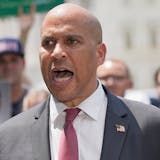As someone who resides four blocks from George Floyd Square, I read with interest "Reach a decision on 38th and Chicago" (editorial, Jan. 18), but was disappointed by its omissions and disinformation. It seems the Star Tribune spoke to a few city leaders but neglected to perform due diligence and include any account from the actual community.
The editorial gives three reasons to open the intersection. First, for first responder access.
However, EMS and the Minneapolis Fire Department have entered the space many times and were not impeded. When questioned directly, both have stated publicly they had no trouble accessing the area.
Second, for safety reasons, referring to an "increase in crime in the area." The Star Tribune reported that crime rose by an even higher rate in other neighborhoods, and City Council Vice President Andrea Jenkins has said, "If George Floyd Square was the only reason for the increase in crime, then every place else in the city and in the country would have stable crime rates, and that is not the case."
Third, access for "street cleaning, rubbish removal and snowplowing." Public Works performs these services daily. And in referencing a (nonscientific) survey, the editorial neglects to mention that 24% of neighbors wrote in that they desired justice before the intersection is opened while 19% would like it closed indefinitely. That combined 43% is especially significant when these weren't even options on the survey.
Has the Star Tribune interviewed more than a handful of city officials to inform this position? When the city put forth the question to the community, "What does justice look like?" neighborhood leaders polled businesses, churches, elders and residents. The result, Resolution 001, outlines 24 demands for justice to open the streets, including jobs for young people, undoing racism training for the Black community and a contingency fund for BIPOC businesses within the area.
The city's response so far has been inadequate. A response to city leadership explained that while what the city is doing generally to address systemic racism is good, they have not yet addressed most of the 24 demands themselves which include direct investment into the communities that immediately surround where George Floyd was killed. So far, the funding proffered has been for existing programs, programs that do not serve this specific area or are nebulous promises such as "co-creating a vision." They do not address the reasonable demands for justice.
This neighborhood has come together in mutual aid and community. This so-called makeshift memorial exists as a full-fledged 501(c)(3) to tell the story as a collaboration between the family of George Floyd and the local community. More than 2,500 offerings of street art, children's drawings, protest signs, rocks, letters, paintings, flowers and meaningful gifts have transformed this into a sacred site and are being preserved. The people are caring for it as well as each other in our fight for justice.



